Financial Management Report: Shareholder Value and Decisions
VerifiedAdded on 2020/10/05
|6
|1387
|216
Report
AI Summary
This report provides a comprehensive overview of financial management, focusing on its core objectives and the critical decisions made from a shareholder's perspective. It delves into investment decisions, examining capital budgeting and the allocation of funds to both current and fixed assets, emphasizing the importance of maximizing the net present value of future earnings. The report also explores financing decisions, highlighting the optimal combination of debt and equity to minimize the hurdle rate and facilitate innovative investments. Dividend decisions are analyzed, discussing the distribution of earnings to shareholders and the impact on share price and firm value. The report further examines the factors influencing each decision, such as investment criteria, cash flow, risk, market conditions, and earnings, providing a detailed understanding of how these elements affect shareholder financial positions. The report concludes that financial management is essential for creating value and maximizing wealth.

FINANCIAL MANAGEMENT
Paraphrase This Document
Need a fresh take? Get an instant paraphrase of this document with our AI Paraphraser
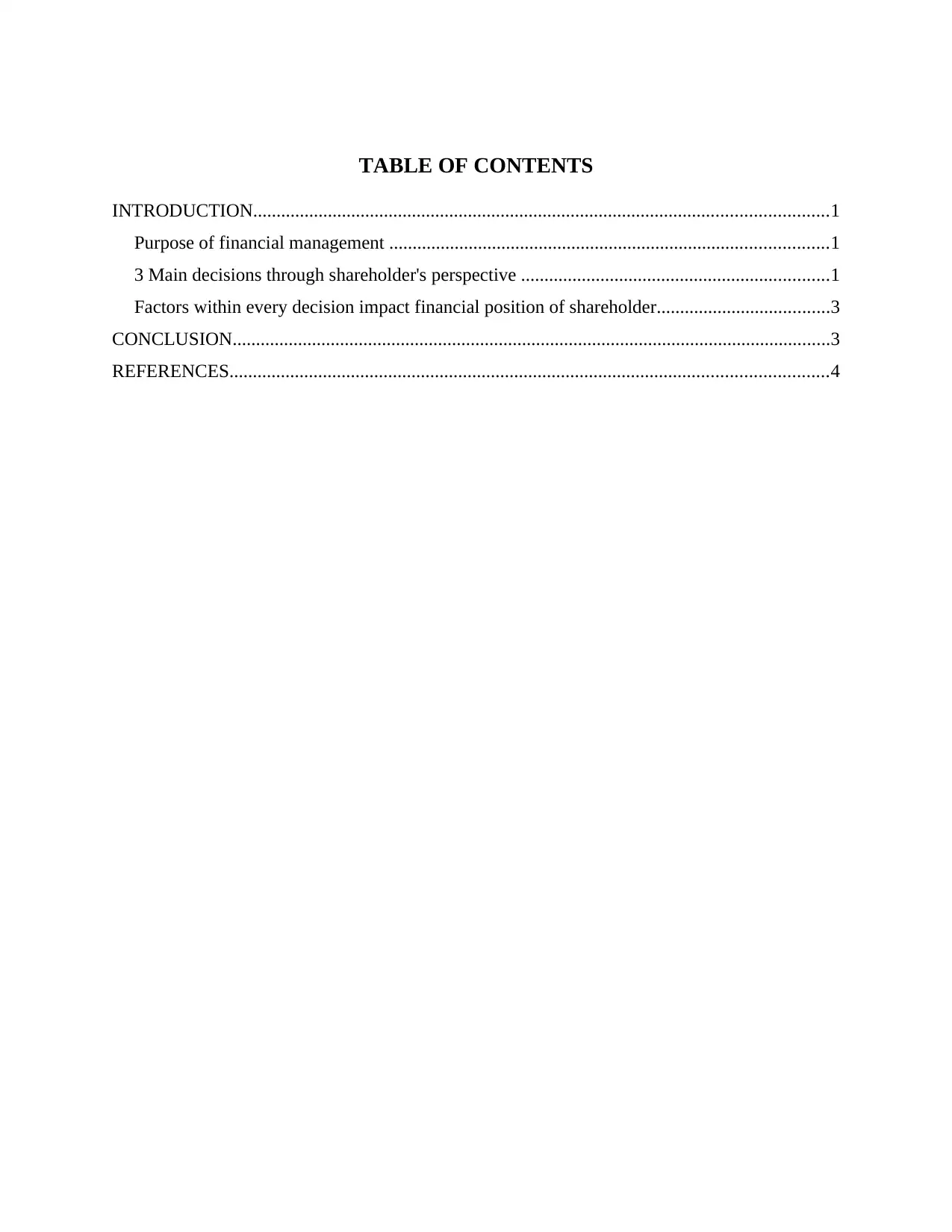
TABLE OF CONTENTS
INTRODUCTION...........................................................................................................................1
Purpose of financial management ..............................................................................................1
3 Main decisions through shareholder's perspective ..................................................................1
Factors within every decision impact financial position of shareholder.....................................3
CONCLUSION................................................................................................................................3
REFERENCES................................................................................................................................4
INTRODUCTION...........................................................................................................................1
Purpose of financial management ..............................................................................................1
3 Main decisions through shareholder's perspective ..................................................................1
Factors within every decision impact financial position of shareholder.....................................3
CONCLUSION................................................................................................................................3
REFERENCES................................................................................................................................4
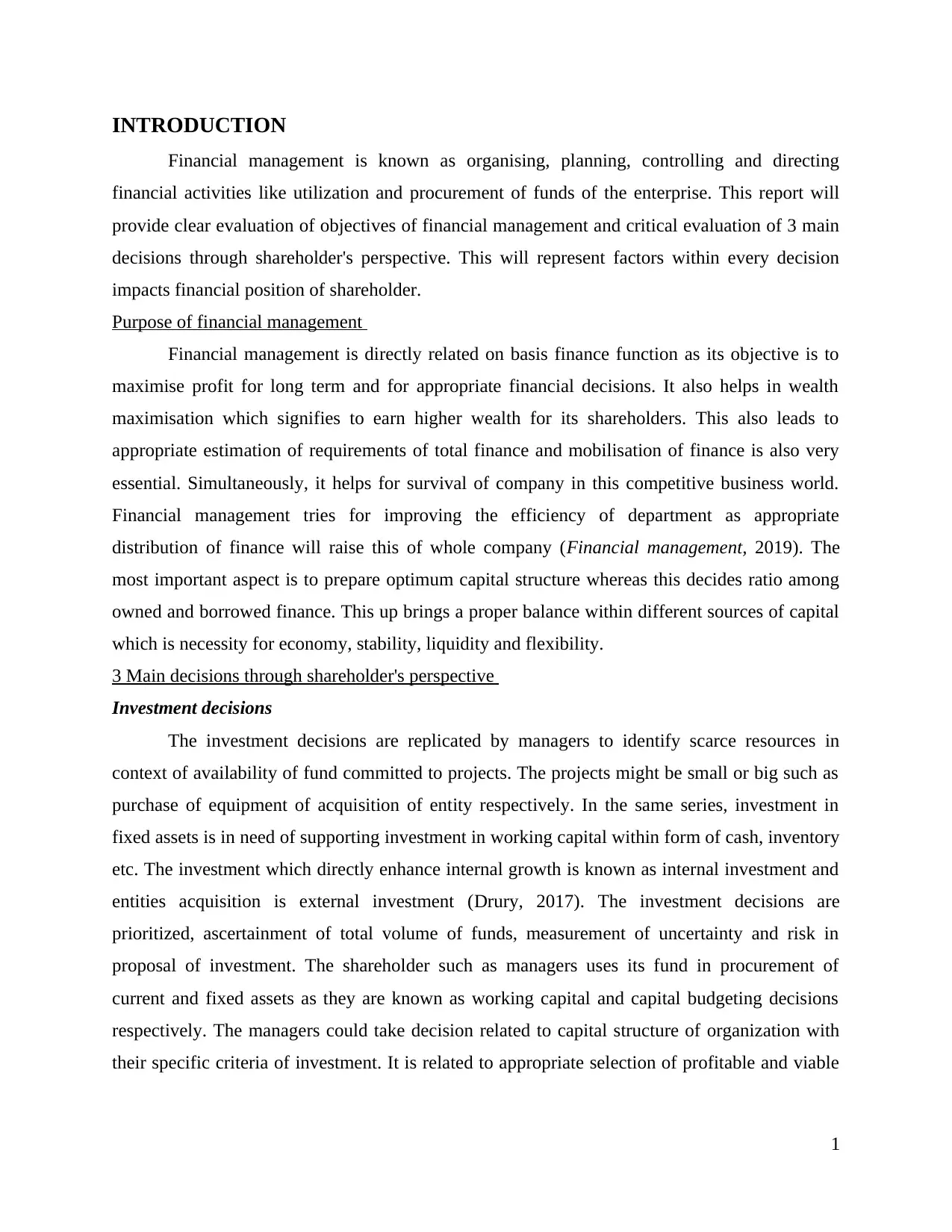
INTRODUCTION
Financial management is known as organising, planning, controlling and directing
financial activities like utilization and procurement of funds of the enterprise. This report will
provide clear evaluation of objectives of financial management and critical evaluation of 3 main
decisions through shareholder's perspective. This will represent factors within every decision
impacts financial position of shareholder.
Purpose of financial management
Financial management is directly related on basis finance function as its objective is to
maximise profit for long term and for appropriate financial decisions. It also helps in wealth
maximisation which signifies to earn higher wealth for its shareholders. This also leads to
appropriate estimation of requirements of total finance and mobilisation of finance is also very
essential. Simultaneously, it helps for survival of company in this competitive business world.
Financial management tries for improving the efficiency of department as appropriate
distribution of finance will raise this of whole company (Financial management, 2019). The
most important aspect is to prepare optimum capital structure whereas this decides ratio among
owned and borrowed finance. This up brings a proper balance within different sources of capital
which is necessity for economy, stability, liquidity and flexibility.
3 Main decisions through shareholder's perspective
Investment decisions
The investment decisions are replicated by managers to identify scarce resources in
context of availability of fund committed to projects. The projects might be small or big such as
purchase of equipment of acquisition of entity respectively. In the same series, investment in
fixed assets is in need of supporting investment in working capital within form of cash, inventory
etc. The investment which directly enhance internal growth is known as internal investment and
entities acquisition is external investment (Drury, 2017). The investment decisions are
prioritized, ascertainment of total volume of funds, measurement of uncertainty and risk in
proposal of investment. The shareholder such as managers uses its fund in procurement of
current and fixed assets as they are known as working capital and capital budgeting decisions
respectively. The managers could take decision related to capital structure of organization with
their specific criteria of investment. It is related to appropriate selection of profitable and viable
1
Financial management is known as organising, planning, controlling and directing
financial activities like utilization and procurement of funds of the enterprise. This report will
provide clear evaluation of objectives of financial management and critical evaluation of 3 main
decisions through shareholder's perspective. This will represent factors within every decision
impacts financial position of shareholder.
Purpose of financial management
Financial management is directly related on basis finance function as its objective is to
maximise profit for long term and for appropriate financial decisions. It also helps in wealth
maximisation which signifies to earn higher wealth for its shareholders. This also leads to
appropriate estimation of requirements of total finance and mobilisation of finance is also very
essential. Simultaneously, it helps for survival of company in this competitive business world.
Financial management tries for improving the efficiency of department as appropriate
distribution of finance will raise this of whole company (Financial management, 2019). The
most important aspect is to prepare optimum capital structure whereas this decides ratio among
owned and borrowed finance. This up brings a proper balance within different sources of capital
which is necessity for economy, stability, liquidity and flexibility.
3 Main decisions through shareholder's perspective
Investment decisions
The investment decisions are replicated by managers to identify scarce resources in
context of availability of fund committed to projects. The projects might be small or big such as
purchase of equipment of acquisition of entity respectively. In the same series, investment in
fixed assets is in need of supporting investment in working capital within form of cash, inventory
etc. The investment which directly enhance internal growth is known as internal investment and
entities acquisition is external investment (Drury, 2017). The investment decisions are
prioritized, ascertainment of total volume of funds, measurement of uncertainty and risk in
proposal of investment. The shareholder such as managers uses its fund in procurement of
current and fixed assets as they are known as working capital and capital budgeting decisions
respectively. The managers could take decision related to capital structure of organization with
their specific criteria of investment. It is related to appropriate selection of profitable and viable
1
⊘ This is a preview!⊘
Do you want full access?
Subscribe today to unlock all pages.

Trusted by 1+ million students worldwide
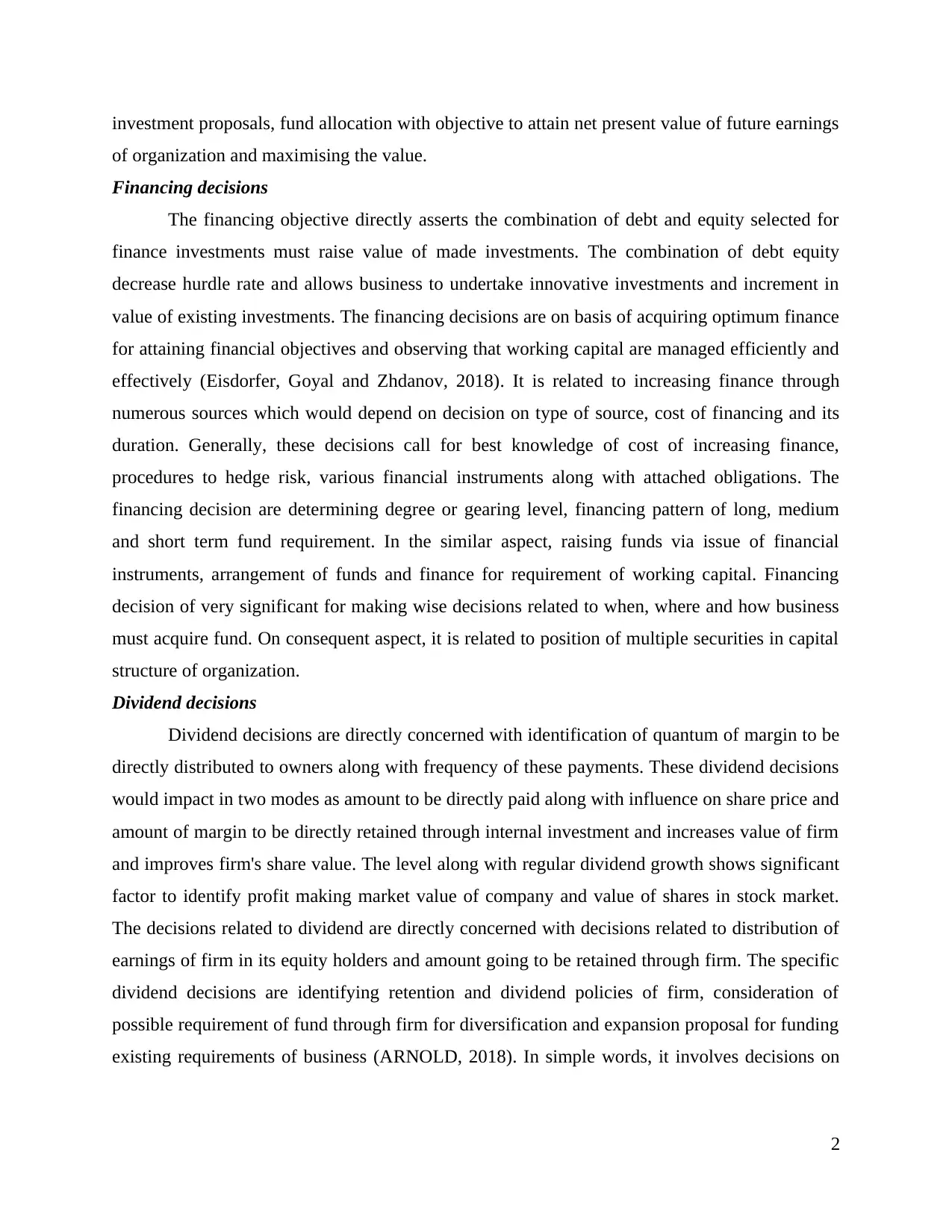
investment proposals, fund allocation with objective to attain net present value of future earnings
of organization and maximising the value.
Financing decisions
The financing objective directly asserts the combination of debt and equity selected for
finance investments must raise value of made investments. The combination of debt equity
decrease hurdle rate and allows business to undertake innovative investments and increment in
value of existing investments. The financing decisions are on basis of acquiring optimum finance
for attaining financial objectives and observing that working capital are managed efficiently and
effectively (Eisdorfer, Goyal and Zhdanov, 2018). It is related to increasing finance through
numerous sources which would depend on decision on type of source, cost of financing and its
duration. Generally, these decisions call for best knowledge of cost of increasing finance,
procedures to hedge risk, various financial instruments along with attached obligations. The
financing decision are determining degree or gearing level, financing pattern of long, medium
and short term fund requirement. In the similar aspect, raising funds via issue of financial
instruments, arrangement of funds and finance for requirement of working capital. Financing
decision of very significant for making wise decisions related to when, where and how business
must acquire fund. On consequent aspect, it is related to position of multiple securities in capital
structure of organization.
Dividend decisions
Dividend decisions are directly concerned with identification of quantum of margin to be
directly distributed to owners along with frequency of these payments. These dividend decisions
would impact in two modes as amount to be directly paid along with influence on share price and
amount of margin to be directly retained through internal investment and increases value of firm
and improves firm's share value. The level along with regular dividend growth shows significant
factor to identify profit making market value of company and value of shares in stock market.
The decisions related to dividend are directly concerned with decisions related to distribution of
earnings of firm in its equity holders and amount going to be retained through firm. The specific
dividend decisions are identifying retention and dividend policies of firm, consideration of
possible requirement of fund through firm for diversification and expansion proposal for funding
existing requirements of business (ARNOLD, 2018). In simple words, it involves decisions on
2
of organization and maximising the value.
Financing decisions
The financing objective directly asserts the combination of debt and equity selected for
finance investments must raise value of made investments. The combination of debt equity
decrease hurdle rate and allows business to undertake innovative investments and increment in
value of existing investments. The financing decisions are on basis of acquiring optimum finance
for attaining financial objectives and observing that working capital are managed efficiently and
effectively (Eisdorfer, Goyal and Zhdanov, 2018). It is related to increasing finance through
numerous sources which would depend on decision on type of source, cost of financing and its
duration. Generally, these decisions call for best knowledge of cost of increasing finance,
procedures to hedge risk, various financial instruments along with attached obligations. The
financing decision are determining degree or gearing level, financing pattern of long, medium
and short term fund requirement. In the similar aspect, raising funds via issue of financial
instruments, arrangement of funds and finance for requirement of working capital. Financing
decision of very significant for making wise decisions related to when, where and how business
must acquire fund. On consequent aspect, it is related to position of multiple securities in capital
structure of organization.
Dividend decisions
Dividend decisions are directly concerned with identification of quantum of margin to be
directly distributed to owners along with frequency of these payments. These dividend decisions
would impact in two modes as amount to be directly paid along with influence on share price and
amount of margin to be directly retained through internal investment and increases value of firm
and improves firm's share value. The level along with regular dividend growth shows significant
factor to identify profit making market value of company and value of shares in stock market.
The decisions related to dividend are directly concerned with decisions related to distribution of
earnings of firm in its equity holders and amount going to be retained through firm. The specific
dividend decisions are identifying retention and dividend policies of firm, consideration of
possible requirement of fund through firm for diversification and expansion proposal for funding
existing requirements of business (ARNOLD, 2018). In simple words, it involves decisions on
2
Paraphrase This Document
Need a fresh take? Get an instant paraphrase of this document with our AI Paraphraser
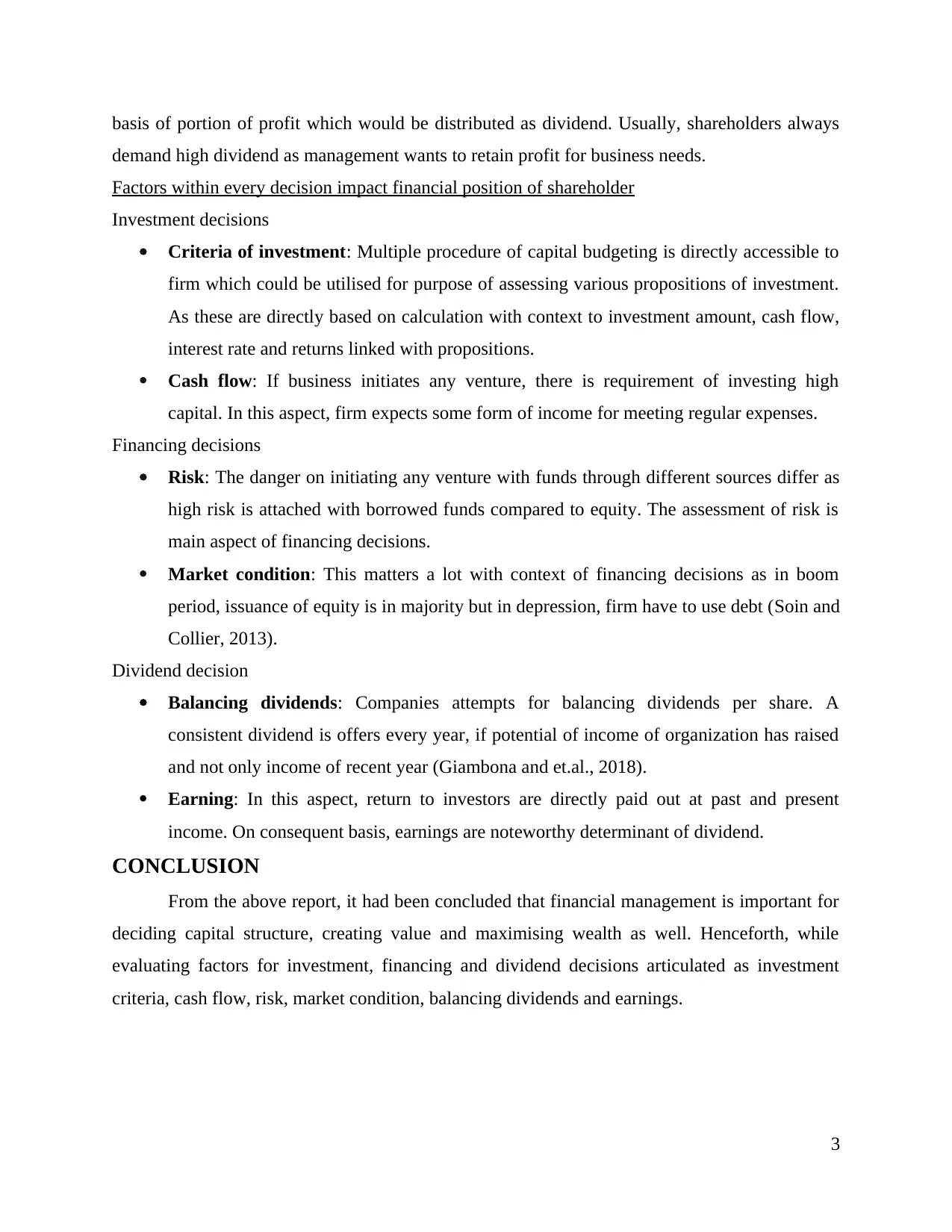
basis of portion of profit which would be distributed as dividend. Usually, shareholders always
demand high dividend as management wants to retain profit for business needs.
Factors within every decision impact financial position of shareholder
Investment decisions
Criteria of investment: Multiple procedure of capital budgeting is directly accessible to
firm which could be utilised for purpose of assessing various propositions of investment.
As these are directly based on calculation with context to investment amount, cash flow,
interest rate and returns linked with propositions.
Cash flow: If business initiates any venture, there is requirement of investing high
capital. In this aspect, firm expects some form of income for meeting regular expenses.
Financing decisions
Risk: The danger on initiating any venture with funds through different sources differ as
high risk is attached with borrowed funds compared to equity. The assessment of risk is
main aspect of financing decisions.
Market condition: This matters a lot with context of financing decisions as in boom
period, issuance of equity is in majority but in depression, firm have to use debt (Soin and
Collier, 2013).
Dividend decision
Balancing dividends: Companies attempts for balancing dividends per share. A
consistent dividend is offers every year, if potential of income of organization has raised
and not only income of recent year (Giambona and et.al., 2018).
Earning: In this aspect, return to investors are directly paid out at past and present
income. On consequent basis, earnings are noteworthy determinant of dividend.
CONCLUSION
From the above report, it had been concluded that financial management is important for
deciding capital structure, creating value and maximising wealth as well. Henceforth, while
evaluating factors for investment, financing and dividend decisions articulated as investment
criteria, cash flow, risk, market condition, balancing dividends and earnings.
3
demand high dividend as management wants to retain profit for business needs.
Factors within every decision impact financial position of shareholder
Investment decisions
Criteria of investment: Multiple procedure of capital budgeting is directly accessible to
firm which could be utilised for purpose of assessing various propositions of investment.
As these are directly based on calculation with context to investment amount, cash flow,
interest rate and returns linked with propositions.
Cash flow: If business initiates any venture, there is requirement of investing high
capital. In this aspect, firm expects some form of income for meeting regular expenses.
Financing decisions
Risk: The danger on initiating any venture with funds through different sources differ as
high risk is attached with borrowed funds compared to equity. The assessment of risk is
main aspect of financing decisions.
Market condition: This matters a lot with context of financing decisions as in boom
period, issuance of equity is in majority but in depression, firm have to use debt (Soin and
Collier, 2013).
Dividend decision
Balancing dividends: Companies attempts for balancing dividends per share. A
consistent dividend is offers every year, if potential of income of organization has raised
and not only income of recent year (Giambona and et.al., 2018).
Earning: In this aspect, return to investors are directly paid out at past and present
income. On consequent basis, earnings are noteworthy determinant of dividend.
CONCLUSION
From the above report, it had been concluded that financial management is important for
deciding capital structure, creating value and maximising wealth as well. Henceforth, while
evaluating factors for investment, financing and dividend decisions articulated as investment
criteria, cash flow, risk, market condition, balancing dividends and earnings.
3
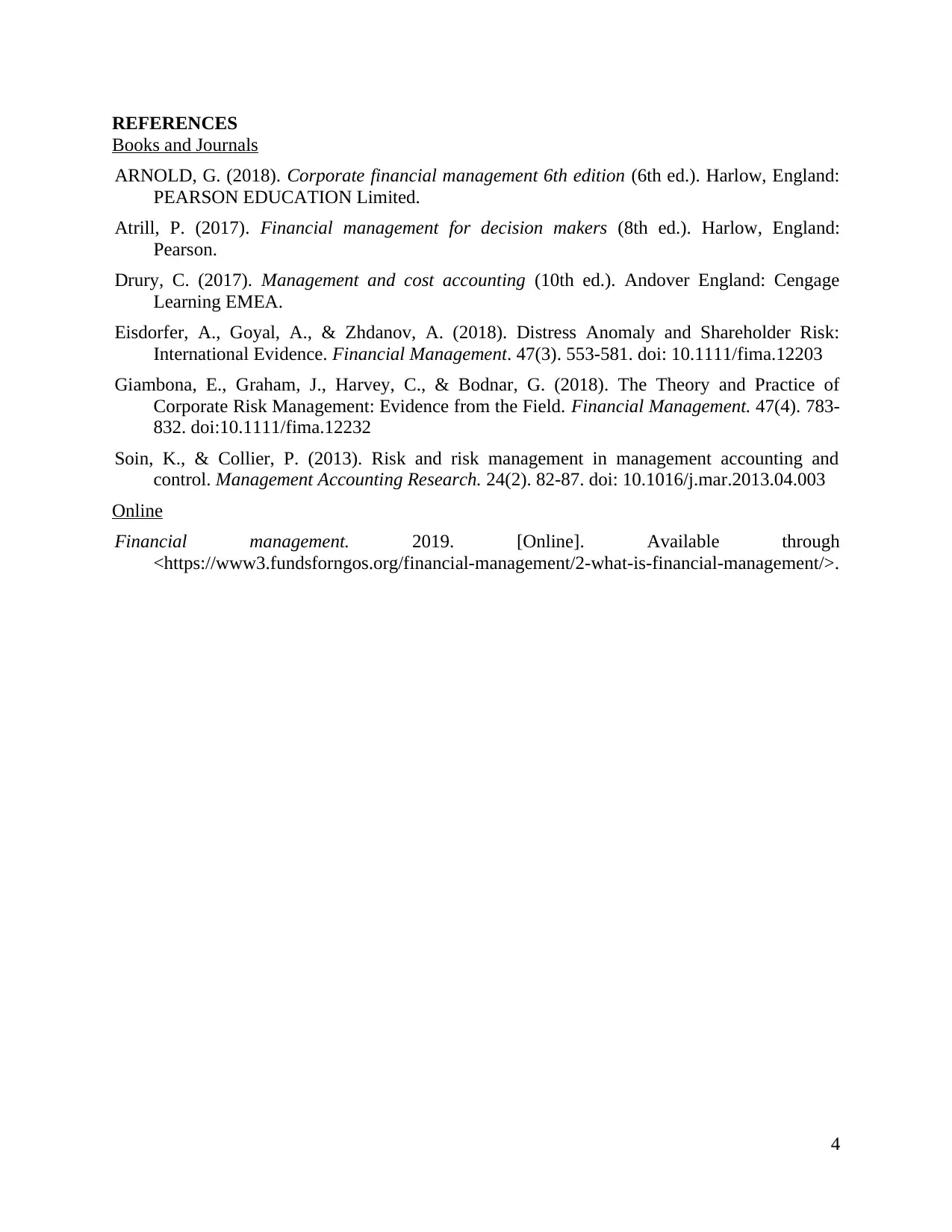
REFERENCES
Books and Journals
ARNOLD, G. (2018). Corporate financial management 6th edition (6th ed.). Harlow, England:
PEARSON EDUCATION Limited.
Atrill, P. (2017). Financial management for decision makers (8th ed.). Harlow, England:
Pearson.
Drury, C. (2017). Management and cost accounting (10th ed.). Andover England: Cengage
Learning EMEA.
Eisdorfer, A., Goyal, A., & Zhdanov, A. (2018). Distress Anomaly and Shareholder Risk:
International Evidence. Financial Management. 47(3). 553-581. doi: 10.1111/fima.12203
Giambona, E., Graham, J., Harvey, C., & Bodnar, G. (2018). The Theory and Practice of
Corporate Risk Management: Evidence from the Field. Financial Management. 47(4). 783-
832. doi:10.1111/fima.12232
Soin, K., & Collier, P. (2013). Risk and risk management in management accounting and
control. Management Accounting Research. 24(2). 82-87. doi: 10.1016/j.mar.2013.04.003
Online
Financial management. 2019. [Online]. Available through
<https://www3.fundsforngos.org/financial-management/2-what-is-financial-management/>.
4
Books and Journals
ARNOLD, G. (2018). Corporate financial management 6th edition (6th ed.). Harlow, England:
PEARSON EDUCATION Limited.
Atrill, P. (2017). Financial management for decision makers (8th ed.). Harlow, England:
Pearson.
Drury, C. (2017). Management and cost accounting (10th ed.). Andover England: Cengage
Learning EMEA.
Eisdorfer, A., Goyal, A., & Zhdanov, A. (2018). Distress Anomaly and Shareholder Risk:
International Evidence. Financial Management. 47(3). 553-581. doi: 10.1111/fima.12203
Giambona, E., Graham, J., Harvey, C., & Bodnar, G. (2018). The Theory and Practice of
Corporate Risk Management: Evidence from the Field. Financial Management. 47(4). 783-
832. doi:10.1111/fima.12232
Soin, K., & Collier, P. (2013). Risk and risk management in management accounting and
control. Management Accounting Research. 24(2). 82-87. doi: 10.1016/j.mar.2013.04.003
Online
Financial management. 2019. [Online]. Available through
<https://www3.fundsforngos.org/financial-management/2-what-is-financial-management/>.
4
⊘ This is a preview!⊘
Do you want full access?
Subscribe today to unlock all pages.

Trusted by 1+ million students worldwide
1 out of 6
Related Documents
Your All-in-One AI-Powered Toolkit for Academic Success.
+13062052269
info@desklib.com
Available 24*7 on WhatsApp / Email
![[object Object]](/_next/static/media/star-bottom.7253800d.svg)
Unlock your academic potential
Copyright © 2020–2025 A2Z Services. All Rights Reserved. Developed and managed by ZUCOL.





